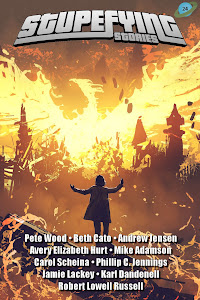When the first bubble appeared, in Mx. Zarblat’s regurgitation chamber, it was the size of a fruit a human might call a melon. It lasted one lunar cycle, before destabilizing and disintegrating, taking a dusty collection of shells with it in the process.
The second bubble appeared in the middle of their town, thankfully out of the way of traffic, and in a flower bed that could use some sprucing up anyway. This one was bigger, almost big enough to fit two or three humanoids, and there were cryptic glyphs and bright yellow stripes around the whole thing. This one stayed, floating in mid-air.
But the third…
The third appeared on top of old friend Grununckle, right where he was standing, lecturing the youth on their lack of standards.
One minute, haranguing. The next minute…
The scientists did all they could think of. The military fired all they had. (Sans the piegogroblaster. It was a populated area, after all.) Nothing could crack that hard metallic shell. It was cordoned off, with a two-block safety zone, monitoring being the only choice left.
Now, we all know that the military are not the brightest of bulbs in any ‘verse, but these—they left the dregs of the dregs to watch the nonexistent readings. This meant there was no one to stop the prophet from approaching with his flock.
The prophet was no green acolyte, fresh to the calling of the people. They had first led a group of believers into the wastelands as a young sprout, many years ago. And though the promised revelation was just chemically purchased, distributed via the shared water source, their pocketbook was full and the next flock beckoned.
This was exultation number five for this profitable prophet—if you were keeping track—but this one they almost believed.
Even though the three-moon night cast an amber glow across the sphere, it still glowed brighter in a white-blue hue and the prophet could not resist laying a hand on its skin.
“It’s hard, and cool!” the prophet proclaimed, running their digits over the seamless metal. “And it feels…it feels like when you scuff your tentacles across a fuzzy floor, and then—”
What else the prophet might have said is a topic hotly debated by those who watched him be chosen by the fourth such bubble of metal. At least by those who came to believe in the metal-bubble rapture.
The proportion of the population who came to believe in the prophet and their wise words about the spheres that started to appear—in increasing frequency—was much higher than the scientists would have liked. Of course, that was always the way when science failed to find an explanation.
A thriving free market sprang up, with specialists all claiming to understand the precise desires and methods of the metal spheres. Where would they appear? Who would they take?
Crime dropped as some folks favored the opinion that they had to be pure. Hatchings skyrocketed as young humanoids threw caution to the wind in the face of what might just be the end.
And the bubbles continued to appear.
Not heeding any predictions, nor any discernible pattern. In this neighborhood or that, in countries around the world. Geologists observed the formation of them in the planet’s crust. Astronomers found them in orbit.
Every so often one would wink back out of existence, but it was always three new orbs appearing to each one dissolving, with the steady growth of orbbed real estate brandished as proof of arguments on all sides.
No one ever returned.
It only took a couple of years before fully a fourth of the planet was consumed by the spheres. A decade before what remained of the population was huddled in the odd sphere-free land. The only common factor among these refuges was a high concentration of certain radiation wisping through the air, causing cancers to bubble and grow in their hosts.
Adapt or die is a universal law, which is what they tried to do, but at the end, when the last few humanoids were left keeping watch for new spheres in their heavens, they still could not help but reach out.
Touch them.
Bargain with them.
Beg them.
Chant the words upon them, which some code-breaker had long ago managed to crack before being taken:
Oh NilSpace, Limited, TR,
Hollow be your spheres.
Property of NilSpace
Let your presence bring me light
Caution: Keep Clear
Make me—
Rebecca A. Demarest (she/her) is an award-winning author, playwright, book designer, and writing instructor living in Seattle, WA with her husband and two muppets. Her short work has appeared alongside authors like Cat Rambo and dramatized for the stage and NPR. When not being held hostage by words, you can find her at her day job (working the people side of unbelievably awesome tech), tending to her indoor jungle, crafting, sewing, playtesting tabletop role playing games, and failing to teach her dogs new tricks. For more information on her work, please visit rebeccademarest.com.




































